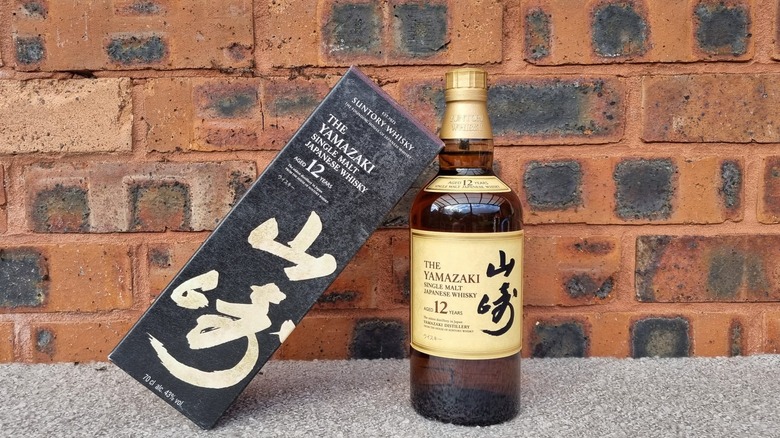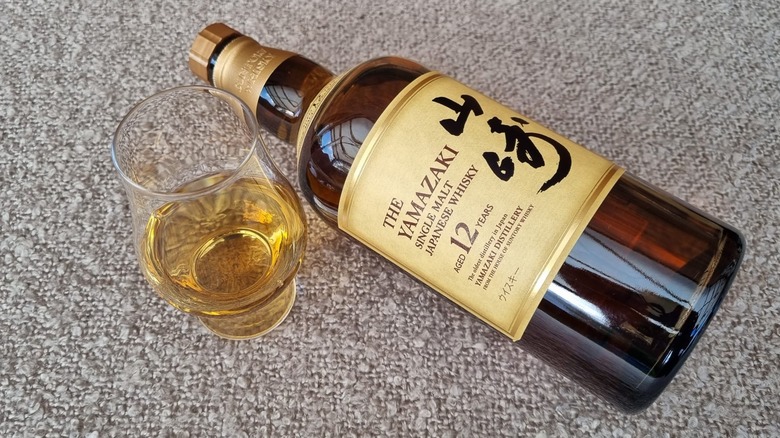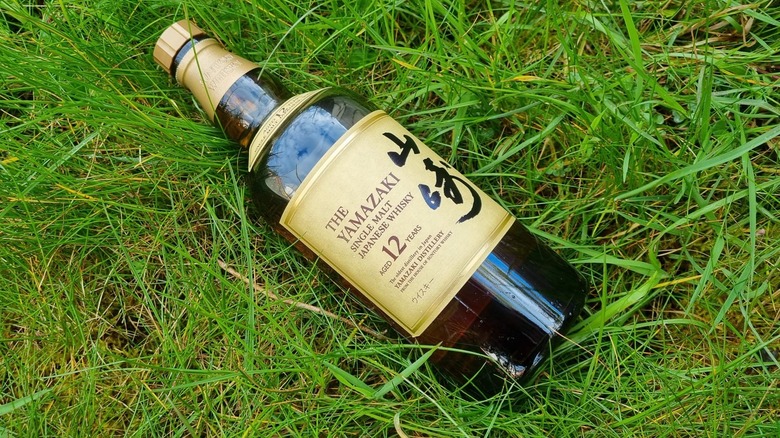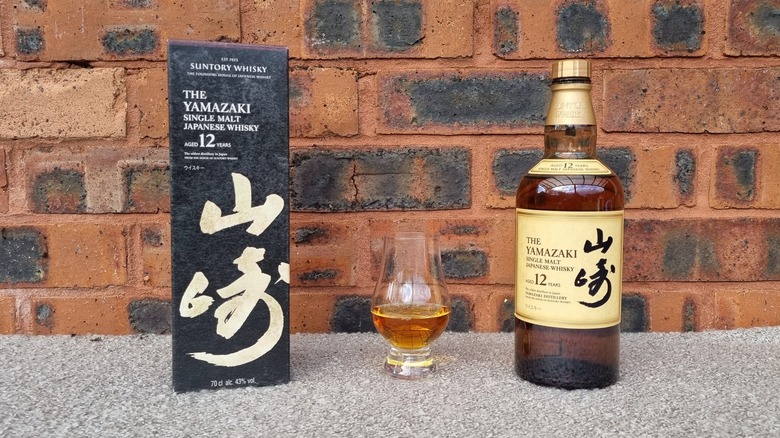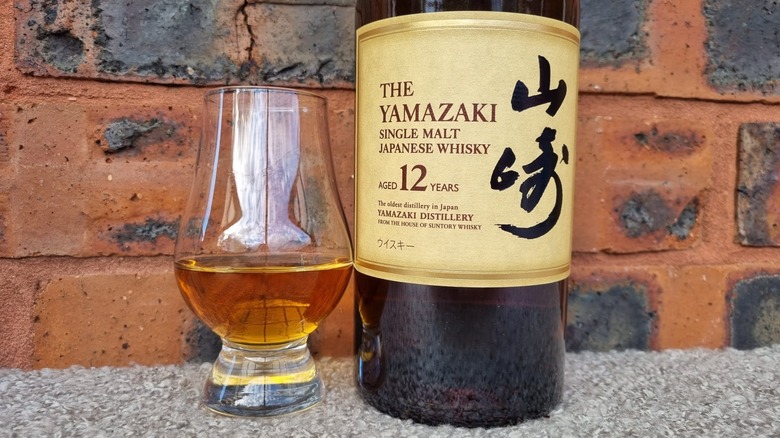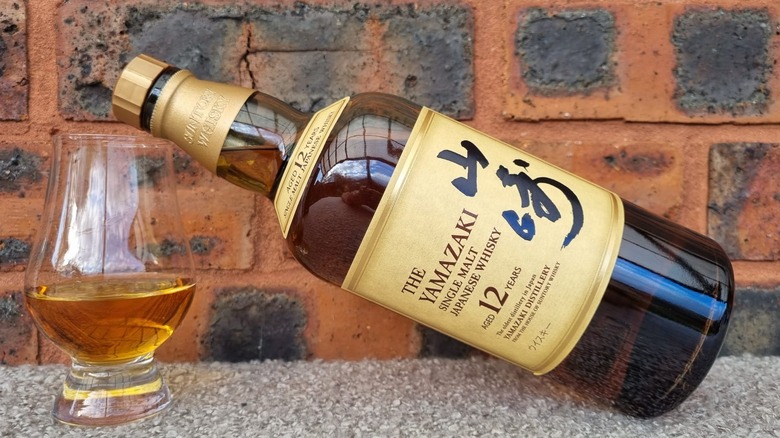Review: Yamazaki 12-Year Japanese Whisky Is An Elegant Yet Costly Whisky
Whisky enthusiasts such as myself have long accepted that Japan can produce whiskies to rival any country in the world, including Scotland. The Yamazaki 12 Year is a great example of the quality and clarity of these bottles. Crafted by the drinks giant Suntory, it's a testament to the craftsmanship of Japanese whisky. However, with Scottish 12-year bottles usually costing much less, it does raise questions about whether the Yamazaki 12 is worthy of both its admiration and price. That's what I set out to discover.
I had the pleasure of sampling this whisky first-hand courtesy of a bottle sent by Suntory. Far from my first bottle of Japanese whisky, I was eager to explore how it compared to other bottles I've sampled from the land of the rising sun. Also, I wanted to see how it stacks up against similarly aged bourbon and Scotch. With my experience as a seasoned whisky lover, I'll be able to give an honest and fair assessment of just how good Yamazaki 12 is. Along the way, I'll delve into the storied depths of this brand and see if it offers good value for money.
Some recommendations are based on first-hand impressions of promotional materials and products provided by the manufacturer/distributor/etc.
What is Yamazaki 12 Year whisky?
This whisky gets its name from the Yamazaki district, which is nestled in serene landscapes not too far from the city of Kyoto. It's the oldest distillery in Japan and dates back to 1923. The location was chosen carefully with the hope of creating a product that bettered what Scotland was producing. One of the reasons for this location and the quality of Yamazaki 12 is the water source. With the distillery situated between two mountains, the water is filtered through granite and becomes beautifully soft and clear. This clarity makes a high-quality Japanese whisky instantly recognizable, as it has a purity to its taste that can't be found elsewhere.
The Yamazaki 12 Year is matured in not one but three different barrels. Mainly using American ex-bourbon casks, the distillery also uses both Spanish oloroso sherry casks and Japanese mizunara oak barrels. The use of mizunara is particularly special as this oak has to be aged for at least 200 years and can be exceptionally expensive due to restrictions on logging. If there was a hall of fame for whisky, Yamazaki 12 would be a lock-in. It was one of the pioneers of Japanese whisky and played a huge role in elevating it to international acclaim. It's another reason this bottle has such an appeal. If you're interested in the history of whisky, this expression is an important part of the story, especially in the 21st century.
Availability and cost of Yamazaki 12 Year
Unless you're familiar with the world of whisky, you may presume that a 12-year-old Japanese bottle would be hard to find. However, the huge rise in popularity of these spirits means you can often find a bottle in many great liquor stores. Unlike some Japanese whisky, the price of Yamazaki isn't determined by scarcity; it is more about the quality of what you get inside. When it comes to the average cost of a 750-milliliter bottle, it sits just around the $200 mark. However, it's important to note that its cost and availability can fluctuate; sometimes, you may need a little patience to get your hands on a bottle.
Stocks at your local liquor store may be limited, but they can usually be found online. Increased global demand can put hurdles in your way, but Yamazaki is increasingly adept at meeting this demand. I mentioned an average price of $200 there, but you can often find deals and retailers selling it for $30 or $40 below this, so it pays to shop around. Many will see it as a steep price, but it would be a memorable addition to any whisky collection.
Yamazaki 12 taste test
I've talked a lot about this whisky thus far, but the crucial question is, what does it taste like? The first thing you'll notice is its stunning golden color. Along with the gold branding on the bottle, it gives the whole package a regal feel. The nose is both unique and beautiful. You're first hit by the mizunara oak, which smells similar to sandalwood with a hint of coconut. Once you get past the oak, you'll get a range of sweeter smells, with most of them being fruity. Grapefruit was the strongest of them, with orange, pineapple, and vanilla also being picked out. When you add subtle spice, you're given a sensory delight before it even passes your lips.
Upon your first taste, you'll find a characteristic common to Japanese whiskies — clarity. The spirit is exceptionally clean with no hint of harshness. If you tasted this blind, you'd most likely estimate it was aged for much longer than its 12 years. You get an initial sweetness in the form of a honeyed malt in what is a full-flavored whisky. It's also spicier than the nose suggests, with some cinnamon and nutmeg, but it doesn't pack too much of a punch.
Further sips reveal a few tropical notes you usually expect when drinking a fine rum. All of these notes are impressively balanced before you get to a satisfyingly dry finish. Overall, it's a graceful whisky that leaves a pleasant and lasting impression on your palate.
Yamazaki 12 vs. Macallan Double Oak 12 Year
You have a few great options for those looking to buy a prestigious 12-year bottle of whisky. If you're trying to decide between a Japanese or Scottish bottle, then a strong contender from the beautiful British country is the Macallan Double Oak 12 Year. I chose this comparison because both bottles have a smooth yet complex elegance to their character. While Suntory has been making whisky since 1923, Macallan's history goes back nearly a century earlier to 1824. The brand has established a reputation for excellence, and this bottle is a good example. As with the Yamazaki, it's aged in both American and European oak but doesn't have the mizunara influence of the Japanese bottle.
In terms of their similarities, this Macallan 12-year is also quite mild with no one flavor dominating the palate, and both also have a subtle and subdued spice. The most distinctive notes from the Scotch are citrus and ginger, with the sweetness coming in the form of honey. Personally, I feel the Yamazaki has a little more to it and beats the Macallan in both depth and warmth. However, the Macallan is often priced around the $85 mark and is widely available. Due to this, it's a tempting option for those who want a great whisky at a cheaper price. Ultimately, both are great whiskies, but going purely on taste, the Yamazaki 12 takes the edge.
Yamazaki 12 is worth it if it's in your budget
The answer depends on your budget. If you have the money to spend and want to sample an exquisite Japanese whisky, you'll see this as money well spent. If you're not sure, review my tasting notes above and see if this is the type of whisky that suits your palate. If you're looking for a clean whisky that gently balances a lovely array of flavors, you'll be more than happy with a bottle of Yamazaki 12. However, there are a few reasons you may want to look elsewhere. If you want to explore the world of Japanese whiskies, there are cheaper alternatives that can start you on your journey. One such example is Suntory's own Toki, which is great value for money, with many stores selling it for around $30.
If you do have budget considerations but still want an exceptional whisky, there are cheaper alternatives, with the Macallan above being a good example. It may also be that you prefer a robust peated Scotch malt or a sweet and complex bourbon. In these instances, Yamazaki 12 may not be a perfect match. There is no getting around Yamazaki being an expensive whisky, especially for a 12-year bottle. Does the exceptional quality and unique flavor justify the cost? If you take the above into account and still want to try it, I'd say yes. It's a historic whisky that epitomizes why Japanese whiskies have become internationally respected.
